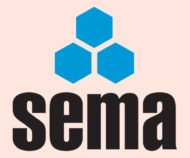Our first question this month is asking about Beam Deflection on recently erected racking and our second is information regarding Load Notices.
 Cross – Beam Deflection
Cross – Beam Deflection
Q. We have recently erected racking & would like to confirm the maximum permitted cross-beam deflection on 1 tonne beams?
A. Generally beam deflection under maximum safe working load will not exceed ‘Span/200’ as recommended in the SEMA Code of Practice for the design of adjustable pallet racking. In other words if you have a 2700mm beam this will give you a maximum allowable 13.5mm deflection.
A deflection of this magnitude is quite noticeable when the lower levels of beams are viewed along the run of the aisle. However this level of deflection is what is allowed in most of the codes of practice worldwide and the designer will have taken this into account when designing the product and will have ensured that an appropriate level of safety is present within the racking.
When checking deflection you should do so from a taut string-line attached to the racking uprights just below the beam rather than measuring from the floor which itself might not be level.
It is of course open to any purchaser of racking equipment to specify tighter deflection tolerances which can be done at increased cost and such tighter standards are sometimes required for the reliable operation of automated equipment. However for typical forklift truck serviced racking the ‘Span/200’ deflection limit is usually adequate.
Load Notice Signage
Q. We have standard warehouse racking in all of our stores and are never going to get anywhere near to the SWL with any of the products that we sell. Typically, a fully loaded bay or run would probably be around 10% of the SWL.
I am aware that HSG76 states that signage should be in place but given that we will never store anywhere near the maximum load allowed, do we still need to provide SWL notices.?
A. You are correct in that there is no specific legislation that requires a load sign to be placed on racking, however, there is an obligation on an employer to ensure that employees have all the information that is needed to operate the racking system safely.
The load notice does not just give information about the SWL of the racking there are also important instructions and information about the general usage of the racking e.g. prohibitions about altering or climbing the racking as well as an instruction to report damage and signposts to information sources.
In your situation the system might operate satisfactorily as long as you are storing your present range of products but if this changes due to a change in your company’s policy or business then there is a need to have within your procedures something which highlights the need to review the carrying capacity of the racking as part of any change that might be made.
It is reasonably foreseeable that in the turmoil of such a policy change within a company such an issue might get overlooked! In the event of an accident the question might be posed as to why the industry standard policy of having load notices on the racks was not followed, who made the decision not to do this and why?
Furthermore, without the load notice you would need to find an alternative means of transmitting all the other useful information given on the load notice to the employees.
Hopefully this explains the logic behind the HSE, Environmental Health and SEMA coming as close to saying load signs are mandatory as possible without actually saying that.
SEMA Annual Safety Conference 2020 – a date for your diary
The 2020 SEMA Safety Conference has been scheduled for Thursday, 5 November; the venue will be the National Motorcycle Museum, Solihull. For full details and a booking form contact SEMA at enquiry@sema.org.uk
SEMA Technical Enquiries
If you have a query send it to us and we will do our best to have it answered by one of our technical experts.
SEMA Rack Safety Awareness and Inspection Courses
SEMA runs a one-day safety course on Rack Safety Awareness and Inspection. These courses are aimed at end users, giving an in-depth look at the need for inspections, how to conduct an assessment and what actions to take when this is completed.
SEMA Approved Rack Inspectors Qualification
Aimed at professionals who conduct rack surveys as an integral and significant part of their duties. It involves delegates in undertaking an in-depth SEMA Course, together with an examination and practical assessment. CPD will be an important part of the qualification, demonstrating to end users that SEMA Approved Inspectors maintain a high professional standard.
SEMA Publications
SEMA has 26 publications in stock – Codes of Practice, ‘Guides’ and European documents.
SEMA USERS Club
SEMA runs a USERS Club designed to be of benefit to purchasers and users of storage equipment. Members receive newsletters, access to specialised events and discounted rates on publications and codes of practice.
SEMA




Comments are closed.